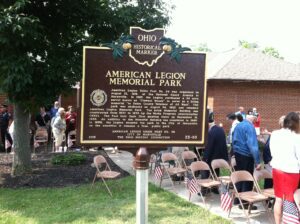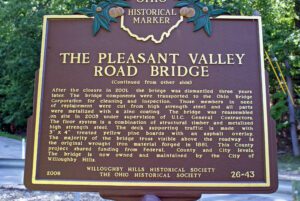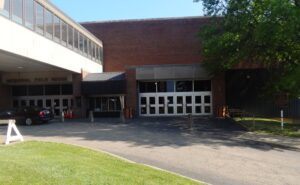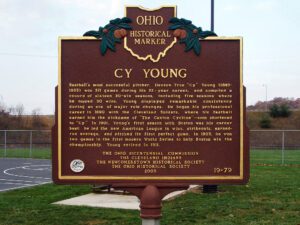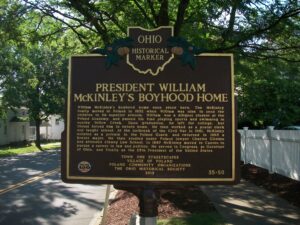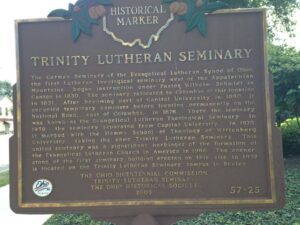, OH
American Legion Union Post No. 79 was organized on August 21, 1919, at the National Guard Armory in Marysville. In 1927, the Legion purchased a 24 acre parcel known as “Clement Woods” to serve as a living memorial “to Union County Veterans of All Wars”. The park was dedicated on August 24, 1927, and renamed American Legion Memorial Park. The brick Memorial Building was constructed from 1937 to 1938 by the Works Progress Administration (WPA). The Post held their first meeting there on September 12, 1938. An addition to the Memorial Building was completed in 1960. In 1989, the Legion donated the park to the City of Marysville on the condition it remains a free, public park.
, OH
This single lane Pleasant Valley Road Bridge was constructed in 1881 by the Wrought Iron Bridge Company of Canton, Ohio, and is a 163 foot-long Whipple Truss (double intersection Pratt through truss). It replaced a wooden bridge that portaged the west branch of the Chagrin River a few hundred yards downstream. The structure, one of less than ten of its kind remaining in the state of Ohio, and possibly the longest in Lake County, was built to sustain the Euclid-Chardon Road traffic on U.S. Route 6. Known as the Grand Army of the Republic Highway, G.A.R., this major thoroughfare served this purpose until 1952 when a new high level bridge bypass was constructed to the south. The Truss bridge, pleasing to the eye with the artwork and name plates atop the overhead portals, was designed to enhance the bridge’s appearance within the valley. (Continued on other side)
, OH
“All life is interrelated in today’s world. I can’t be what I ought to be until you are what you ought to be; and you can’t be what you ought to be ’till I am what I ought to be.” Dr. Martin Luther King Jr. spoke these words before 3,500 people while addressing a Freedom Rally here on March 20, 1964. His speech addressed issues of racial equality and unity, and urged passage of the Civil Rights Act. On July 2, 1964, President Lyndon B. Johnson signed the act into law, prohibiting discrimination based on a person’s race, color, religion, sex, or nationality.
, OH
Greek Christian refugees from Asia Minor migrated to Canton in the early 1900s settling in the industrial area known as “Carnahan.” Erected in 1917, Holy Trinity Greek Orthodox Church was chartered by Elies Korosedes, Nick Kessenides, Alex Heropoulos, Harry Achilles, and Paul Paulidis. It cost $50,000 to build and was repaid within 3 years by parishioners, mostly laborers earning 30 cents an hour. In 1927, a separate building Koraes Hall was added as a social and cultural center. It was later connected to the church in 1934. The property was sold in 1976 and subsequently changed ownership many times. On September 2, 2020, a devastating fire destroyed the former Koraes Hall, rendering the remaining structure unsafe. City officials condemned the buildings for demolition and buried the remnants beneath the ground.
, OH
Baseball’s most successful pitcher, Denton True “Cy” Young (1867-1955) won 511 games during his 22-year career, and compiled a record of sixteen 20-win seasons, including five seasons where he topped 30 wins. Young displayed remarkable consistency during an era of major rule changes. He began his professional career in 1890 with the Cleveland Spiders, where his fastball earned him the nickname of “The Canton Cyclone”–soon shortened to “Cy.” In 1901, Young’s first season with Boston was his career best: he led the new American League in wins, strikeouts, earned-run average, and pitched its first perfect game. In 1903, he won two games in the first modern World Series to help Boston win the championship. Young retired in 1911.
, OH
William McKinley’s boyhood home once stood here. The McKinley family moved to Poland in 1852 when William was nine to send the children to its superior schools. William was a diligent student at the Poland Academy, and passed his time playing sports and swimming in nearby Yellow Creek. Upon graduation, he left for college, but illness forced him to return home. He then worked as a postal clerk and taught school. At the outbreak of the Civil War in 1861, McKinley enlisted as a private in the Poland Guard, and returned in 1865 a brevet major. He then studied under Poland lawyer Charles Glidden and attended Albany Law School. In 1867 McKinley moved to Canton to pursue a career in law and politics. He served in Congress, as Governor of Ohio, and finally as the 25th President of the United States.
, OH
The German Seminary of the Evangelical Lutheran Synod of Ohio, the first Lutheran theological seminary west of the Appalachian Mountains, began instruction under Pastor Wilhelm Schmidt in Canton in 1830. The seminary relocated to Columbus at this location in 1831. After becoming part of Capital University in 1850, it occupied temporary campuses before locating permanently on the National Road, east of Columbus, in 1876. There the seminary was known as the Evangelical Lutheran Theological Seminary. In 1959, the seminary separated from Capital University. In 1978, it merged with the Hamma School of Theology of Wittenberg University, taking the name Trinity Lutheran Seminary. This united seminary was a significant harbinger of the formation of the Evangelical Lutheran Church in America in 1988. The cornerstone of the first seminary building erected on this site in 1832 is located on the Trinity Lutheran Seminary campus in Bexley.


